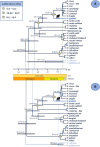The Genome of Plasmodium gonderi: Insights into the Evolution of Human Malaria Parasites
- PMID: 38376987
- PMCID: PMC10901558
- DOI: 10.1093/gbe/evae027
The Genome of Plasmodium gonderi: Insights into the Evolution of Human Malaria Parasites
Erratum in
-
Correction to: The Genome of Plasmodium gonderi: Insights into the Evolution of Human Malaria Parasites.Genome Biol Evol. 2024 Mar 2;16(3):evae057. doi: 10.1093/gbe/evae057. Genome Biol Evol. 2024. PMID: 38526170 Free PMC article. No abstract available.
Abstract
Plasmodium species causing malaria in humans are not monophyletic, sharing common ancestors with nonhuman primate parasites. Plasmodium gonderi is one of the few known Plasmodium species infecting African old-world monkeys that are not found in apes. This study reports a de novo assembled P. gonderi genome with complete chromosomes. The P. gonderi genome shares codon usage, syntenic blocks, and other characteristics with the human parasites Plasmodium ovale s.l. and Plasmodium malariae, also of African origin, and the human parasite Plasmodium vivax and species found in nonhuman primates from Southeast Asia. Using phylogenetically aware methods, newly identified syntenic blocks were found enriched with conserved metabolic genes. Regions outside those blocks harbored genes encoding proteins involved in the vertebrate host-Plasmodium relationship undergoing faster evolution. Such genome architecture may have facilitated colonizing vertebrate hosts. Phylogenomic analyses estimated the common ancestor between P. vivax and an African ape parasite P. vivax-like, within the Asian nonhuman primates parasites clade. Time estimates incorporating P. gonderi placed the P. vivax and P. vivax-like common ancestor in the late Pleistocene, a time of active migration of hominids between Africa and Asia. Thus, phylogenomic and time-tree analyses are consistent with an Asian origin for P. vivax and an introduction of P. vivax-like into Africa. Unlike other studies, time estimates for the clade with Plasmodium falciparum, the most lethal human malaria parasite, coincide with their host species radiation, African hominids. Overall, the newly assembled genome presented here has the quality to support comparative genomic investigations in Plasmodium.
Keywords: Plasmodium falciparum; Plasmodium vivax; GC content; molecular clock; phylogenomics; synteny.
© The Author(s) 2024. Published by Oxford University Press on behalf of Society for Molecular Biology and Evolution.
Figures






Similar articles
-
Apicoplast phylogeny reveals the position of Plasmodium vivax basal to the Asian primate malaria parasite clade.Sci Rep. 2019 May 13;9(1):7274. doi: 10.1038/s41598-019-43831-1. Sci Rep. 2019. PMID: 31086239 Free PMC article.
-
Phylogeny of Asian primate malaria parasites inferred from apicoplast genome-encoded genes with special emphasis on the positions of Plasmodium vivax and P. fragile.Gene. 2010 Jan 15;450(1-2):32-8. doi: 10.1016/j.gene.2009.10.001. Gene. 2010. PMID: 19818838
-
Lineage-specific positive selection at the merozoite surface protein 1 (msp1) locus of Plasmodium vivax and related simian malaria parasites.BMC Evol Biol. 2010 Feb 19;10:52. doi: 10.1186/1471-2148-10-52. BMC Evol Biol. 2010. PMID: 20167126 Free PMC article.
-
Progress in understanding the phylogeny of the Plasmodium vivax lineage.Parasitol Int. 2022 Apr;87:102507. doi: 10.1016/j.parint.2021.102507. Epub 2021 Nov 12. Parasitol Int. 2022. PMID: 34781012 Review.
-
Out of Africa: origins and evolution of the human malaria parasites Plasmodium falciparum and Plasmodium vivax.Int J Parasitol. 2017 Feb;47(2-3):87-97. doi: 10.1016/j.ijpara.2016.05.008. Epub 2016 Jul 2. Int J Parasitol. 2017. PMID: 27381764 Free PMC article. Review.
Cited by
-
Remarkable Evolutionary Rate Variations Among Lineages and Among Genome Compartments in Malaria Parasites of Mammals.Mol Biol Evol. 2024 Dec 6;41(12):msae243. doi: 10.1093/molbev/msae243. Mol Biol Evol. 2024. PMID: 39570730 Free PMC article.
-
Modeling Substitution Rate Evolution across Lineages and Relaxing the Molecular Clock.Genome Biol Evol. 2024 Sep 3;16(9):evae199. doi: 10.1093/gbe/evae199. Genome Biol Evol. 2024. PMID: 39332907 Free PMC article. Review.
-
Phylogenetics and genomic variation of Hepatocystis isolated from shotgun sequencing of wild primate hosts.PLoS Pathog. 2025 Jun 18;21(6):e1013240. doi: 10.1371/journal.ppat.1013240. eCollection 2025 Jun. PLoS Pathog. 2025. PMID: 40531971 Free PMC article.
-
Origin of the human malaria parasite Plasmodium vivax.Trends Parasitol. 2024 Jul;40(7):562-572. doi: 10.1016/j.pt.2024.05.001. Epub 2024 May 28. Trends Parasitol. 2024. PMID: 38806300 Free PMC article. Review.
References
-
- Auburn S, Böhme U, Steinbiss S, Trimarsanto H, Hostetler J, Sanders M, Gao Q, Nosten F, Newbold CI, Berriman M, et al. A new Plasmodium vivax reference sequence with improved assembly of the subtelomeres reveals an abundance of pir genes. Wellcome Open Res. 2016:1:4. 10.12688/wellcomeopenres.9876.1. - DOI - PMC - PubMed
-
- Aunin E, Böhme U, Sanderson T, Simons ND, Goldberg TL, Ting N, Chapman CA, Newbold CI, Berriman M, Reid AJ. Genomic and transcriptomic evidence for descent from Plasmodium and loss of blood schizogony in Hepatocystis parasites from naturally infected red colobus monkeys. PLoS Pathog. 2020:16(8):e1008717. 10.1371/journal.ppat.1008717. - DOI - PMC - PubMed
Publication types
MeSH terms
Grants and funding
LinkOut - more resources
Full Text Sources
Medical
Research Materials
Miscellaneous

